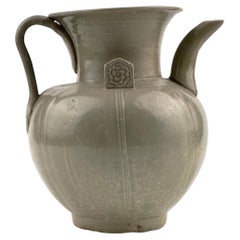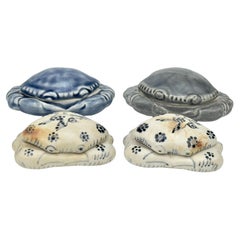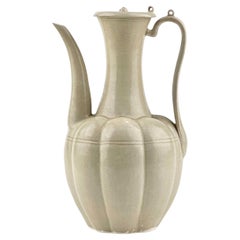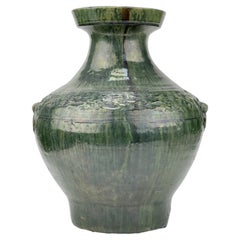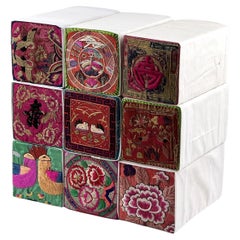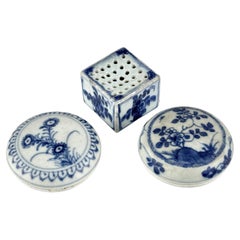South Korea - Antiquities
to
222
254
885
424
254
240
11
3
243
72
44
40
28
254
172
153
82
73
254
254
254
Item Ships From: South Korea
Yue Celadon Ewer, Late Tang-Northern Song Dynasty
Located in seoul, KR
This Yue ware celadon ewer features a gracefully rounded body that expands smoothly, complemented by a wide, flaring mouth. The translucent olive-green glaze envelops the surface, en...
Category
15th Century and Earlier Hong Kong Tang Antique South Korea - Antiquities
Materials
Celadon
$3,150 Sale Price
30% Off
Two Pair of Annamese Porcelain Crab Boxes, 15th century, Le Dynasty
Located in seoul, KR
Vietnamese stoneware crab boxes. Light blue glaze. This is one of the representative types of miniature works of Hoi An ships.
Dates : 15th century Le Dyn...
Category
15th Century and Earlier Vietnamese Antique South Korea - Antiquities
Materials
Ceramic, Porcelain
$1,953 Sale Price
30% Off
A Rare Cream-Glazed Ding yao Ewer and Cover, Northern Song Dynasty (960–1127)
Located in seoul, KR
The octagonal lobed ovoid body rising from a short spreading foot to a tall trumpet neck, set at the shoulder with a tall curved spout and to the other side with a tall strap handle, the dished cover surmounted with a ruyi-shaped finial, covered overall in a creamy-white glaze. Compared to other similar types of Northern Song Dynasty ceramics, this piece is extremely elegant in shape. It most closely resembles the Qingbai porcelain in the collection of The Museum of Oriental Ceramics in Osaka.
Period : Northern Song dynasty(960~1127)
Type : Creamy-white Ding yao glaze Ewer
Provenance : Acquired in 1999, Hongkong
Reference : THE MET Accession Number: 18.57.1
Sotheby's London 2018 - St George Street Sale Asian Art - Lot 208
* Song Dynasty Ding-Yao Ware
Song Dynasty Ding Yao porcelain holds a significant place in Chinese ceramic art, specifically as a type of white porcelain produced during the Song Dynasty. Produced predominantly during the mid to late Song Dynasty, Ding Yao ceramics are renowned for their delicate and intricate features.
Ding Yao ceramics were primarily crafted from clay rich in white minerals and fired at high temperatures to achieve a durable and lustrous surface. One distinctive characteristic of this serene white ceramic is the presence of silver or gold-colored splashes of glaze, often created using a mineral called galena. Galena, with its lustrous appearance, was suitable for creating fine patterns and intricate decorations.
These ceramics frequently feature delicate carvings, floral motifs, or subtle decorations. While commonly used for utilitarian purposes such as tableware, Ding Yao porcelain also served as a medium for artistic expression, producing many artworks. The production of Ding Yao ceramics was relatively limited, and surviving pieces are considered rare and valuable art pieces...
Category
15th Century and Earlier Hong Kong Antique South Korea - Antiquities
Materials
Ceramic
$17,970 Sale Price
70% Off
Hu vase with green glaze, Han Dynasty
Located in seoul, KR
It is made from a fairly high-fired reddish pottery and coated in a particularly attractive glossy thick streaky green and finely-crackled glaze, the colour of which varies according...
Category
15th Century and Earlier Hong Kong Han Antique South Korea - Antiquities
Materials
Stoneware
$2,992 Sale Price
25% Off
Nine Sqare Auspicious Korean Traditional Embroidered Pillows
Located in seoul, KR
These traditional Korean embroidered pillows, often included in a bride's dowry during the modern era, symbolize auspicious blessings for a harmonious and prosperous married life. Fe...
Category
19th Century South Korean Antique South Korea - Antiquities
Materials
Fabric
$1,950 Sale Price
35% Off
Two Cosmetic Box and a Square Box from Ca Mau Ship, Qing Dynasty, Yongzheng Era
Located in seoul, KR
1. Left Round Cosmetic Box : Circular form with flattened doomed cover, the covers with a medallion of simple stylised flowers surrounded by stylised lapp...
Category
Early 18th Century Vietnamese Qing Antique South Korea - Antiquities
Materials
Ceramic
$1,625 Sale Price / set
35% Off
Three Annamese Small Yuhuchunping, 15th century, Le Dynasty
Located in seoul, KR
These 15th-century Annamese ceramics from Le dynasty, are notable for their rarity and refined design. The Yuhuchunping vases, with their elegant pear-shaped bodies and delicate blue-and-white motifs, showcase the sophisticated craftsmanship of the time. They offer a glimpse into the vibrant maritime trade networks of Southeast Asia during the 15th century, making them valuable artifacts in the study of East Asian ceramics...
Category
15th Century and Earlier Vietnamese Antique South Korea - Antiquities
Materials
Ceramic
$1,800 Sale Price / set
40% Off
A Copper-Red Ceramic Bowl with Auspicious Motifs, Ming-Early Qing Dynasty
Located in seoul, KR
A copper-red produced in Jingdezhen, China, during the Ming to early Qing dynasty (15th–17th century). It features a copper red applied over a bluish-white glaze, which is glaze type...
Category
16th Century Hong Kong Ming Antique South Korea - Antiquities
Materials
Copper
$2,660 Sale Price
30% Off
Blue And White Vase, Qing Dynasty, Kangxi Era, Circa 1690
Located in seoul, KR
Vung Tau Shipwreck Coralized Blue Underglazed Porcelain Lidded Vase. Almost perfectly Identical piece from Vietnamese Royal Family in United States provenance have been sold at other auction in California. This stunning porcelain lidded vase is elaborately decorated in a vivid blue underglaze with an ornate scene of concubines in a flower garden. The bottom of the vase bears a conch marking in underglazed blue, is a symbol of royalty, dignity and high rank, the 'Sacred Lungs of Buddha' and spiritual authority.
Period : Qing Dynasty, Kangxi reign
Production Date : 1690-1699
Made in : Jingdezhen
Destination : Amsterdam
Found/Acquired : Southeast Asia , South China Sea, Vung Tau Ship
Reference : Double checked with reference to the original catalogues
1) Christies Amsterdam 1992 - Vung Tau Cargo...
Category
1690s Vietnamese Qing Antique South Korea - Antiquities
Materials
Ceramic
$1,885 Sale Price
35% Off
Changsha Bowl from Belitung Ship, Tang Dynasty
Located in seoul, KR
The edges have been dipped in four places with brown, probably iron-oxide. The well of the bowl is freely painted in deep green and coffee coloured brown. These are characteristic fe...
Category
15th Century and Earlier Indonesian Tang Antique South Korea - Antiquities
Materials
Pottery
$1,625 Sale Price
35% Off
Two Yixing Zisha Teapots and Covers
Located in seoul, KR
Both Yixing Zisha teapots appear to be modern to republic-era pieces. Yixing Zisha teapots are made from rare Zisha (紫砂) clay, which is exclusively...
Category
20th Century East Asian South Korea - Antiquities
Materials
Pottery
$975 Sale Price / set
35% Off
Blue And White Kraak Plate, Late Ming Dynasty
Located in seoul, KR
A Chinese blue and white Kraak plate, the central roundel depicting birds and floral design in a waterside, the rim with panels enclosing foliage and decorative objects.
Period: Late Ming-Early Qing Dynasty (17th century)
Type: Blue and White Porcelain
Provenance : Acquired early 2000s from Southeast asia(Probably from Shipwreck)
Reference :
1) Sotheby's London 12 November 2019 - STYLE: Private Collections - Lot 12
(Price range : 3,000GBP-5,000GBP / Type : Closely related)
2) Christies NEW YORK - 1–11 MAY 2018 - THE COLLECTION OF PEGGY AND DAVID ROCKEFELLER: ONLINE SALE - Lot 1405
(Price realised : 5,625 USD / Type : Highly related)
* Kraak
Kraak porcelain is a type of Chinese export porcelain that was produced during the late Ming Dynasty, especially during the reign of the Wanli Emperor (1573-1620). It is famous for its distinctive design and style. Kraak ware...
Category
17th Century Indonesian Ming Antique South Korea - Antiquities
Materials
Ceramic, Porcelain
$1,495 Sale Price
50% Off
A Grey Pottery Figure of Boar(Wild Pig), Han Dynasty
Located in seoul, KR
This piece is an ancient terracotta animal sculpture in the form of a pig, rendered in a simple yet vivid manner. The pig stands firmly on four stout legs, with a short and solidly m...
Category
15th Century and Earlier Hong Kong Han Antique South Korea - Antiquities
Materials
Pottery
$2,700 Sale Price
40% Off
Earthenware Ewer, Yi
Located in seoul, KR
This terracotta vessel was fired to a warm yellow-brown that shows subtle oxidation marks across the surface. Entirely unglazed, it retains a matte, tactile finish with fine pores an...
Category
15th Century and Earlier East Asian Antique South Korea - Antiquities
Materials
Earthenware, Pottery
$1,300 Sale Price
35% Off
Two Annamese Miniature Kettle, 15th century, Le Dynasty
Located in seoul, KR
These 15th-century Le Dynasty ceramic vessels from northern Vietnam feature distinct designs. One is beige with faint blue floral patterns, a rounded body, and an elongated spout. Th...
Category
15th Century and Earlier Vietnamese Antique South Korea - Antiquities
Materials
Ceramic
$903 Sale Price / set
35% Off
Porcelain with transparent pale-bluish (qingbai-type) glaze, Yuan Dynasty
Located in seoul, KR
This piece is shaped like a lotus bud, featuring a gracefully undulating body and intricate geometric patterns. The neck is adorned with finely incised dense lines, adding visual var...
Category
15th Century and Earlier Hong Kong Antique South Korea - Antiquities
Materials
Ceramic, Porcelain
$1,225 Sale Price
30% Off
A Molded Longquan Celadon 'Fu Shou' Ewer, Ming Dynasty
Located in seoul, KR
One side of the vase showcases a panel with the Shou character at its center, symbolizing longevity, while the opposite side displays the Fu character, signifying luck. The neck of the vase is adorned with leaves. There are similar types and decoration but varying in shape, resembling a pear, all from the same era and crafted in celadon, often referred to as 'fu shou' vases.
Period: Yuan-Ming Dynasty (1271-1644)
Region: Longquan, China
Medium: Celadon
Type: Ewer
Provenance : Acquired in late 1990s from Hongkong
Reference
1) British Museum - Museum number 1931,1118.5
(Type : Closely related)
2) Christies NEW YORK 24–25 MAR 2022 - Important Chinese Ceramics and Works of Art - Lot 1105
(Price realised : 9,450 USD / Type : Related)
3) Sotheby's New York 19 March 2024 - Chinese Art - Lot 172
(Price range : 15,000 USD - 20,000 USD / Type : Related)
* Ming Dynasty Longquan Celadon
Longquan celadon from the Ming Dynasty typically exhibits a more robust and heavier stoneware body compared to its Song Dynasty predecessors. The Ming era saw an evolution in celadon glaze, achieving a wider spectrum of green hues, from olive to bluish-greens. Ming celadons...
Category
15th Century and Earlier Hong Kong Ming Antique South Korea - Antiquities
Materials
Celadon
$1,995 Sale Price
50% Off
A Large Straw Glazed Pottery Figure of a Solider, Sui to Tang Dynasty
Located in seoul, KR
This well-modeled ceramic figure depicts a Scythian warrior in full armor, likely serving as a standard bearer. The warrior stands upright on a thin rectangular base, with clenched f...
Category
15th Century and Earlier Hong Kong Tang Antique South Korea - Antiquities
Materials
Straw
$1,275 Sale Price
25% Off
Annamese Stoneware Dish with Lotus Motif, 15-16th Century Vietnam, Le Dynasty
Located in seoul, KR
This Annamese ceramic dish features a central lotus motif, enclosed by a thin circular border. The rim is adorned with intertwining vine patterns and swirling motifs. The dish has a gently curved form with a well-proportioned depth and a neatly finished rim.
Dates : 15th century Le Dynasty
Region : North Annam, Vietnam
Type : Dish
Found/Acquired : Southeast Asia , South China Sea, Hoi An Ship
Reference : Double checked with reference to the original catalogue
Butterfield Treasures Hoi An Hoard Auction Catalogs / San Francisco Butterfields 2000
* Vietnamese trade ceramics
Around the mid-14th century, Vietnam developed its ceramics production technology by producing blue and white porcelain, and began to export it overseas. During this period, China Ming Dynasty implemented a policy of lifting the ban from 1371 to 1657 and restricted foreign trade. This served as a good opportunity in the trade history of Vietnamese ceramics, and ceramic exports...
Category
15th Century and Earlier Vietnamese Ming Antique South Korea - Antiquities
Materials
Stoneware
$1,393 Sale Price
30% Off
Two Yixing Teapots and Covers
Located in seoul, KR
Both Yixing Zisha teapots appear to be modern-Republic era pieces. Yixing Zisha teapots are made from rare Zisha (紫砂) clay, which is exclusively mi...
Category
20th Century East Asian South Korea - Antiquities
Materials
Pottery
$975 Sale Price / set
35% Off
A Zhejiang Porcelain Ewer, Northern Song Dynasty
Located in seoul, KR
The oviform body is divided into few lobes. All covered in a finely crackled pale olive-green glaze. The surface and glaze characteristics are definitive, confirming the authenticity...
Category
15th Century and Earlier Hong Kong Antique South Korea - Antiquities
Materials
Porcelain
$2,925 Sale Price
35% Off
Neolithic Pottery Amphora(Gansu Province), 3rd-2nd Millenium BC
Located in seoul, KR
Neolithic Vase with raised neck, slightly flared, two handles. Geometric designs and stylized bovine heads in black. Acquired in Hong Kong in the late 1990s.
Date : 3,000-2,000 BC
M...
Category
15th Century and Earlier Hong Kong Antique South Korea - Antiquities
Materials
Earthenware, Pottery
$2,600 Sale Price
35% Off
Rare Famille Rose/Verte Shipwreck Ceramics Set, Qing Dynasty, Yongzheng Era
Located in seoul, KR
Beautiful 'chickens and flowers' painted rare familie rose/verte ceramic set from Qing dynasty. Excavated from cargo underwater from the early Qing dynasty. It is presumed to originate from the Yongzheng period Ca Mau Shipwreck. On the back of the baluster vase, there are traces of marine organisms. This type of famille porcelain...
Category
Early 18th Century Vietnamese Qing Antique South Korea - Antiquities
Materials
Ceramic
$2,660 Sale Price / set
30% Off
Celadon Vase, Five Dynasties or Northern Song dynasty, 10th-11th Century
Located in seoul, KR
The form of Longquan celadon vases from the Northern Song dynasty evolved from an early design with a long neck and tapering body to a later ovoid body with a shorter neck. Over time, the glaze developed a more olive tone, and the carved decorations became more pronounced and intricate. Examples of such vases include one without a cover dated to the Yuanfeng era (1078~1085) and documented in literature, and another similar vase without loop handles preserved by the Qingyuan County Cultural Relics Bureau. An earlier example featuring loop handles and a lotus-like cover is also mentioned in historical texts.
The use of Longquan covered vases, especially as funerary jars for offerings like wine and grains, was highlighted by an inscription on a piece from the Sir Percival David Collection, London. This inscription wishes for the vessel to preserve fragrant wine for centuries, blessing the owner with prosperity, longevity, and a vast lineage, dated to the third year of the Yuanfeng period (1080). This practice was common in the regions of Southern Zhejiang and Northern Fujian. A similar celadon vase from the Linyushanren collection was auctioned at Christie’s Hong Kong, emphasizing the cultural and historical significance of these artifacts.
Period : Five Dynasties or Northern Song Dynasty
Type : Celadon, Zhejiang province
Medium : Celadon
Size : 31.5 cm(Height) x 11.5(Diameter)
Provenance : Acquired in late 1990s from Hongkong
Reference :
1) The British Museum image id - 01613270570
2) Christies New York 23–24 MAR 2023 - Important Chinese Ceramics and Works of Art - Lot 1012
(Price Range : USD 18,000 – USD 25,000 / Type : Related)
3) National Gallery of Victoria - Accession Number - AS5-1973
* Celadon from Five Dynasties (907~960) to the early Northern Song Dynasty (960~1127)
The period from the Five Dynasties (907~960) to the early Northern Song Dynasty (960~1127) marked a significant transitional phase in the development of Chinese celadon ceramics...
Category
15th Century and Earlier Hong Kong Antique South Korea - Antiquities
Materials
Celadon
$3,960 Sale Price
60% Off
Large Pottery Standing Figure of Attendant, Han dynasty
Located in seoul, KR
This artwork, acquired in Hong Kong during the 1990s, is presumed to have been produced in the same kiln from the Han dynasty, based on the head of the Sotheby's reference piece, which also originated from Hong Kong. Furthermore, given its almost identical shape to the piece from the Artemis Gallery...
Category
15th Century and Earlier Hong Kong Han Antique South Korea - Antiquities
Materials
Pottery
$3,213 Sale Price
30% Off
A Large and Rare Straw-Glazed Pottery Amphora, Tang Dynasty
Located in seoul, KR
The ovoid shape suggests the influence from “amphora” of Greece and Rome, while the dragon-shaped handles allude to Persian and Central Asian metalwork. The ubiquitous dragon is a Ea...
Category
15th Century and Earlier Hong Kong Tang Antique South Korea - Antiquities
Materials
Pottery, Stoneware
$8,125 Sale Price
35% Off
Large Changsha Bowl from Belitung Ship, Tang Dynasty
Located in seoul, KR
The edges have been dipped in four places with brown, probably iron-oxide. The well of the bowl is freely painted in deep green and coffee coloured brown. These are characteristic fe...
Category
15th Century and Earlier Indonesian Tang Antique South Korea - Antiquities
Materials
Pottery
$2,800 Sale Price
30% Off
Brown Glazed Teabowls from Ca Mau Ship, Qing Dynasty, Yongzheng Era
Located in seoul, KR
These teabowls feature a simple yet elegant form, finished with a brown glaze that creates a smooth, subtle sheen. They have thin, evenly crafted walls and a small, stable footring t...
Category
18th Century Vietnamese Qing Antique South Korea - Antiquities
Materials
Ceramic
$1,260 Sale Price / set
30% Off
Sancai-Glazed ‘Floral’ Dish, Liao Dynasty(916~1125)
Located in seoul, KR
Well potted with shallow sides rising from a short foot, the interior molded with a single chrysanthemum surrounded by peony blossoms picked out in amber and with green leaves agains...
Category
15th Century and Earlier Hong Kong Tang Antique South Korea - Antiquities
Materials
Pottery, Stoneware
$3,835 Sale Price
35% Off
Green-Glazed Dish, Han Dynasty
Located in seoul, KR
This Han Dynasty green-glazed dish exhibits significant signs of wear, indicative of its age and the long passage of time it has witnessed. The glaze, once vibrant, now shows substan...
Category
15th Century and Earlier Hong Kong Han Antique South Korea - Antiquities
Materials
Earthenware
Changsha Bowl from Belitung Ship, Tang Period
Located in seoul, KR
The back side edges have been dipped in four places with brown, probably iron-oxide. The well of the bowl is freely painted in deep green and coffee coloured brown. These are charact...
Category
15th Century and Earlier Indonesian Tang Antique South Korea - Antiquities
Materials
Pottery
$1,950 Sale Price
35% Off
Large Cizhou Jar, Yuan Dynasty
Located in seoul, KR
This vase is sturdily potted with a robust ovoid body that rises from a short, spreading foot to a gently tapering neck, finishing with a lipped mouth rim. The exterior is decorated ...
Category
15th Century and Earlier Hong Kong Antique South Korea - Antiquities
Materials
Pottery
$4,495 Sale Price
50% Off
16th Century Pottery Model of a Folding Chair, Ming dynasty
Located in seoul, KR
This piece is an example of Mingqi, items specifically crafted for burial to accompany the deceased into the afterlife. The terracotta army is the most renowned example of such buria...
Category
16th Century Hong Kong Ming Antique South Korea - Antiquities
Materials
Pottery
$903 Sale Price
35% Off
Rare annamese cream glazed ewer, Vietnam, 11-15th century
Located in seoul, KR
Famous annamese cream glazed ceramic ewer covered with a cream glaze. Traces of excavation are clearly visible in the glaze.
Dates : Presumably Ly Dynasty (11-13th century)
Region ...
Category
15th Century and Earlier Vietnamese Antique South Korea - Antiquities
Materials
Ceramic, Stoneware
Gate Pillar, Han Dynasty(206BC-220AD)
Located in seoul, KR
The Han Dynasty gate pillar held by the Asian Art Museum in San Francisco and this gate pillar are the only known examples of their type worldwide, highlighting its extraordinary rar...
Category
15th Century and Earlier Hong Kong Han Antique South Korea - Antiquities
Materials
Earthenware
$5,985 Sale Price / set
25% Off
Three Annamese Small Blue Lidded Boxes, 15th century, Le Dynasty
Located in seoul, KR
These are three small lidded boxes from the Vietnamese period, specifically from the 15th century during the Le Dynasty.
Dates : 15th century Le Dynasty
Region : North Annam, Viet...
Category
15th Century and Earlier Vietnamese Antique South Korea - Antiquities
Materials
Ceramic
$954 Sale Price / set
40% Off
Earthenware Pottery Jar, Han Dynasty(206 BC-220 AD)
Located in seoul, KR
This jar would have served as a mortuary object (mingqi), placed in a tomb as a substitute for the more valuable bronze and lacquer vessels. Along with a variety of other funerary earthenware objects, attendant figures, and animals, richly decorated vessels of this kind were intended to serve the spirit of the deceased in the afterlife.
Period : Han dynasty
Type : Jar
Medium : Earthenware
Dimension : 28.5 cm(Height) x 11cm(Mouth Diameter)
Condition : Good(Overall in well-preserved ancient burial condition with some soil still adhering (showing minor abrasions and wear due to prolonged burial underground)
Provenance : Acquired in late 1990s from Hongkong
* Han Dynasty Earthenware...
Category
15th Century and Earlier Hong Kong Han Antique South Korea - Antiquities
Materials
Earthenware
$2,093 Sale Price
30% Off
Qingbai Lotus Censer, Song Dynasty
Located in seoul, KR
This exquisite Qingbai piece, acquired in Hong Kong in the late 1990s, is a high-quality artifact from the Southern Song Dynasty, likely produced at the Hutian Kiln. The base exhibit...
Category
15th Century and Earlier Hong Kong Antique South Korea - Antiquities
Materials
Ceramic
$10,000 Sale Price
50% Off
Cizhou slender meiping, Yuan Dynasty
Located in seoul, KR
The elongated body is fluidly painted in brown on a white slip and under a clear glaze with a broad band of abstract floral scroll between a band of upright petals below and further ...
Category
15th Century and Earlier Hong Kong Other Antique South Korea - Antiquities
Materials
Stoneware
$7,996 Sale Price
60% Off
Rare Yue Celadon Chicken-Head Ewer, Jin-Southern Dynasty
Located in seoul, KR
Chicken-head ewers are among the most distinct and emblematic pottery pieces from the Han (206 BC - AD 220) to the Tang (618-907) dynasties. Their production commenced during the Jin...
Category
15th Century and Earlier Hong Kong Han Antique South Korea - Antiquities
Materials
Celadon, Stoneware
$7,160 Sale Price
60% Off
Teapots with Cover from Ca Mau Ship, Qing Dynasty, Yongzheng Reign
Located in seoul, KR
The teapot on the left features a rounded body densely adorned with blooming flowers and intertwining vines, creating a flowing and repetitive pattern. The delicate brushstrokes emph...
Category
18th Century Vietnamese Qing Antique South Korea - Antiquities
Materials
Ceramic
$1,820 Sale Price / set
35% Off
Funerary Model of a Granary, Han dynasty
Located in seoul, KR
Cylindrical vessel on three animal-shaped feet (dragon or snake), wall with profile grooves, roof. pottery with green lead glaze. "Iridescence" is observed in surface.
Period : Han...
Category
15th Century and Earlier Hong Kong Han Antique South Korea - Antiquities
Materials
Pottery
$1,400 Sale Price
30% Off
Two Glazed Court Attendants, Ming Period (1368-1644)
Located in seoul, KR
Two finely hollow-moulded terracotta statuettes from ancient China, dating to the Ming Dynasty. The figure is depicted standing, dressed in long, flowing robes, painted in vibrant blue or green and deep amber yellow. The hair is styled into an elaborate top-knot, painted in a muted brown. Areas left unpainted would have been 'cold-painted' after firing, contrasting with the vivid fired blue or green and amber pigments. The figure is shown with the left hand raised to the chest, as if holding something, possibly an offering or incense. Figurines like this were placed in tombs to guide the deceased on their journey to the afterlife.
The Ming Dynasty was known for its exceptional artistic achievements, partly due to its economic prosperity. Since the Han Dynasty, it was customary to bury terracotta miniatures of everyday objects with the deceased. These items, known as mingqi, or "spirit utensils" and "vessels for ghosts," were believed to help and assist the deceased in the afterlife. Mingqi were crafted in the form of cooking utensils, miniature replicas of houses, temples, furniture, and other items. Anthropomorphic and zoomorphic terracotta figures were also popular, designed to assist, entertain, and recreate the living world for the deceased.
Period: Ming Dynasty
Medium: Green/blue-glazed Pottery
Type: Figure
Provenance : Acquired in late 1990s from Hongkong
Reference :
1) Ancient & Oriental - Terracotta Tomb Attendants
(Type : Highly related)
2) La Maison De La Petite Sara S.r.l. - Archaeology section - A Black glazed Terracotta Statuette, Servant with Trumpet, Ming Dynasty
(Price realised : 700 GBP / Type : Highly related)
* Ming Dynasty Glazed Pottery Figures
Ming Dynasty glazed pottery figures are renowned for their bold color palette, intricate detailing, and lifelike forms, distinguishing them from earlier traditions. These figures, which depict officials, warriors, animals, and mythical creatures, are characterized by high-gloss lead-based glazes in green, amber, ochre, and sancai (three-color) combinations. The thickly applied glaze pools in recesses, creating depth and enhancing sculptural details. With dynamic postures, expressive facial features, and meticulously rendered drapery, these figures reflect the period’s advancement in ceramic craftsmanship, offering a greater sense of movement and realism compared to the rigid and stylized forms of earlier dynasties.
A defining characteristic of Ming glazed pottery is its elaborate surface detailing, often achieved through raised relief elements and contrasting glazes. Equestrian figures, for example, feature carefully sculpted saddles, harnesses, and decorative embellishments, while human figures are adorned with intricate robes and headdresses. The large scale of these tomb figures, often more imposing than those from previous periods, underscores the increasing importance of funerary art during the Ming era. Unlike later Qing Dynasty figures...
Category
15th Century and Earlier Hong Kong Ming Antique South Korea - Antiquities
Materials
Pottery
$1,943 Sale Price / set
35% Off
Large Yue Globular Stoneware Jar, Han Dynasty-Three Kingdoms
Located in seoul, KR
Robustly crafted with a voluminous spherical body and a layered mouth rim, this jar features a pair of taotie handles. It is adorned with three horizontal bands on the upper half of ...
Category
15th Century and Earlier Hong Kong Han Antique South Korea - Antiquities
Materials
Stoneware
$2,793 Sale Price
30% Off
Annamese Dish Circa 15th Century, Le Dynasty
Located in seoul, KR
Its surface is coated with a smooth, glossy white or cream-colored glaze, exuding a clean and elegant finish. At the center, a geometric motif painted in black pigment draws the eye,...
Category
15th Century and Earlier Vietnamese Antique South Korea - Antiquities
Materials
Stoneware
$1,500 Sale Price
40% Off
Blue and White Baluster Vase, Qing Dynasty, Kangxi Era, Circa 1690
Located in seoul, KR
The baluster shaped vase rising from a splayed foot to a short waisted neck, decorated in underglaze blue with flower blooms borne on leafy stems.
Period : Qing Dynasty, Kangxi reign
Production Date : 1690-1699
Made in : Jingdezhen
Destination : Amsterdam
Found/Acquired : Southeast Asia , South China Sea, Vung Tau...
Category
1690s Vietnamese Chinoiserie Antique South Korea - Antiquities
Materials
Ceramic
Large Pottery Standing Figure of Attendant, Han dynasty
Located in seoul, KR
The statuette shows traces of the original red, black, and white pigmentation. The figure’s body, head, and hands (which in this case are lost) were all made separately to give her an essence of movement and dynamism. Given its almost identical shape to the piece from the Artemis Gallery...
Category
15th Century and Earlier Hong Kong Han Antique South Korea - Antiquities
Materials
Pottery
$2,334 Sale Price
34% Off
'Peacock in Splendour' Pattern Dish, c1725, Qing Dynasty, Yongzheng Era
Located in seoul, KR
A representative piece of Ca Mau ship. With a tall peacock standing on a rocky outcrop displaying his feathers to a peahen who crouches on the ground before him...
Category
1720s Vietnamese Chinoiserie Antique South Korea - Antiquities
Materials
Ceramic
$3,894 Sale Price
34% Off
Green Glazed Horse and Rider, Ming period(15-16th Century)
Located in seoul, KR
Statues of East Asian horse rider, featuring glazes in green, are set on rectangular base.
Period: Ming Dynasty
Medium: Green-glazed Pottery
Type: Figure
Condition : Good
Provenance : Acquired in early 2000s from Hongkong
* Ming Dynasty Glazed Pottery Figures
Ming Dynasty glazed pottery figures are renowned for their bold color palette, intricate detailing, and lifelike forms, distinguishing them from earlier traditions. These figures, which depict officials, warriors, animals, and mythical creatures, are characterized by high-gloss lead-based glazes in green, amber, ochre, and sancai (three-color) combinations. The thickly applied glaze pools in recesses, creating depth and enhancing sculptural details. With dynamic postures, expressive facial features, and meticulously rendered drapery, these figures reflect the period’s advancement in ceramic craftsmanship, offering a greater sense of movement and realism compared to the rigid and stylized forms of earlier dynasties.
A defining characteristic of Ming glazed...
Category
15th Century and Earlier Hong Kong Ming Antique South Korea - Antiquities
Materials
Pottery
$1,625 Sale Price
35% Off
Blue and White Porcelain Meiping Vase with Peony Scroll, Ming Dynasty
Located in seoul, KR
This piece is presumed to be a blue and white porcelain meiping vase from the mid-Ming Dynasty. The entire body is decorated with arranged peony scrolls painted in underglaze cobalt blue. The vivid yet dark navy tone of the cobalt pigment suggests it may have been produced using pigment typical of the early to mid-Ming period.
The decorative bands, such as the cloud motifs and the lotus petal patterns, contribute to the overall sense of proportion and harmony. The intricate brushwork and density of the design indicate a skilled artisan’s hand. The balanced form and the shape of the foot provide clues for dating the piece.
Period: Mid-Late Ming Dynasty
Medium: Blue and White Porcelain
Type: Meiping
Size : 3.5cm(Mouth Diameter), 27cm(Height)
Provenance : Acquired in late 1990s from Hongkong
Reference : Sotheby's Paris 10 December 2019 - VASE EN PORCELAINE BLEU BLANC...
Category
16th Century East Asian Ming Antique South Korea - Antiquities
Materials
Ceramic
$3,250 Sale Price
35% Off
Ten Auspicious Korean Traditional Embroidered Pillows
Located in seoul, KR
Ten traditional embroidered pillows given by a bride to her husband as part of her dowry during marriage in Korea's modern era. These embroidered designs convey auspicious messages r...
Category
19th Century Korean Antique South Korea - Antiquities
Materials
Fabric
$1,950 Sale Price
35% Off
An Exceptional Gilt-Bronze Dragon, Presumably Six Dynasties
Located in seoul, KR
An art piece presumably from the Six Dynasties period in China, spanning from the 3rd to the 6th centuries. This era is known for its political fragmentation but also significant cul...
Category
15th Century and Earlier Hong Kong Antique South Korea - Antiquities
Materials
Bronze
$16,250 Sale Price
35% Off
A Straw-Glazed Pottery Figure of a man on Horseback, Sui to Tang Dynasty
Located in seoul, KR
The rider is seated upright, wearing a smoothly draped robe with finely sculpted folds. The red markings on the garment surface are likely either soil deposits or remnants of pigment...
Category
15th Century and Earlier Hong Kong Tang Antique South Korea - Antiquities
Materials
Pottery, Straw
$975 Sale Price
35% Off
Qingbai Melon form water ewer, Five Dynasties-Northern song dynasty
Located in seoul, KR
The oviform body is divided into few lobes, and the shoulder is applied with a pair of small loops molded.
Period : Five Dynasties-Song Dynasty(907~1279)
Type : Ewer
Medium : Zheji...
Category
15th Century and Earlier Hong Kong Antique South Korea - Antiquities
Materials
Porcelain
$1,495 Sale Price
50% Off
Small Qingbai Pear-Shaped Vase, Song-Yuan Dynasty(13-14th century)
Located in seoul, KR
This exquisite piece is a Qingbai ware from the Song to Yuan dynasty, and it appears to be an excavated artifact given its earthy encrustations, suggesting it has rested in the groun...
Category
15th Century and Earlier Hong Kong Antique South Korea - Antiquities
Materials
Ceramic, Porcelain
$895 Sale Price
50% Off
Green-Glazed Pottery Elephant, Han dynasty
Located in seoul, KR
This piece is an elephant statue made of green-glazed pottery. During the Han Dynasty, artworks depicting elephants were quite rare. However, such representations did occasionally appear. For example, the bronze vessel from the Han Dynasty housed in the Shanghai Museum is one of the notable examples of this type of craftsmanship. The existence of elephants in ancient China is attested both by archaeological evidence and by depictions in Chinese artwork. Long thought to belong to an extinct subspecies of the Asian elephant named Elephas maximus...
Category
15th Century and Earlier Hong Kong Han Antique South Korea - Antiquities
Materials
Pottery
$3,742 Sale Price
25% Off
Yanyan Vase from Vung Tau Ship, Qing Dynasty Kangxi Era, Circa 1690
Located in seoul, KR
Each side pencil-painted with stylized chrysanthemum, lotus or daisy sprays issuing from rockwork. This blue and white square vase with rounded sides has a flaring mouth and a long neck. This shape can be traced back to Chinese bronzes. It is decorated with floral motifs on four sides in underglaze blue.
This piece was originally part of a pair, but the other has already been sold.
Period : Qing Dynasty, Kangxi Period(1690-1699)
Origin : Jingdezhen
Destination : Netherland
Found/Acquired : Southeast Asia , South China Sea, Vung Tau Ship
Reference : Double checked with reference to the original catalogues below
1) Christies Amsterdam 1992 - Vung Tau Cargo...
Category
17th Century Vietnamese Antique South Korea - Antiquities
Materials
Ceramic
$2,310 Sale Price
30% Off
A Russet-Splashed Blackish-Brown-Glazed Jar, Song Dynasty
Located in seoul, KR
Lustrous blackish-brown glaze decorated on the exterior with lines of splashes of russet color. This jar features a rounded and voluminous body, with its shoulders gently curving upward to meet the lid. The lid is topped with a small knob-like handle at the center, creating a harmonious and well-balanced overall proportion.
Under microscopic magnification, the brown-glazed...
Category
15th Century and Earlier Hong Kong Antique South Korea - Antiquities
Materials
Ceramic
$8,775 Sale Price
35% Off
A Rare Sancai-Glazed Pottery Jar, Tang Dynasty
Located in seoul, KR
The jar is of globular shape and is decorated to the body with a geometric design band of lozenge-shaped motifs in blue, green, ochre and cream below a plain ochre everted mouth rim,...
Category
15th Century and Earlier Hong Kong Tang Antique South Korea - Antiquities
Materials
Earthenware
$7,950 Sale Price
50% Off
Lang Yao Water Coupe, Qing Period
Located in seoul, KR
This ceramic piece features a low, rounded form with a narrow mouth, exemplifying refined simplicity and balance. The surface is covered in a rich, deep crimson glaze, likely derived...
Category
18th Century East Asian Qing Antique South Korea - Antiquities
Materials
Ceramic
$1,500 Sale Price
25% Off
Recently Viewed
View AllMore Ways To Browse
Kimekomi Dolls
Luristan Bronze
Luristan Dagger
Monkey Gong
Pegu Bronze
Ruo Shen
Wheat Thrasher
11th Century Vishnu Stone Statue
Antique Cast Iron Hibachi
Dinosaur Statue
Han Dynasty Stick Man
Leather Rice Paddy Shoes
Vintage Bone China Flowers
Vintage Bull Figurine
Vintage Cast Iron Fire Basket
Vintage Ceramic Pig
Vintage Cowboy Saddle
Vintage Dragon Figurine
